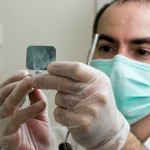
Endodontic surgery is undertaken where there is persistence of periapical lesions where non-surgical endodontic treatment has failed or is not feasible. The main aims being to eliminate infection and allow bone healing. The increasing use of bone regenerative technique in periodontal and implant surgery has led to increased interest in their use as an adjunct to endodontic surgery although results have been variable.
The aim of this review was to assess the influence of different regenerative techniques and materials on the outcome of endodontic surgery.
Methods
Searches were conducted in the Cochrane Central Register of Controlled Trials (CENTRAL), Embase, PubMed, SinoMed, Web of Science, OpenGrey and Google Scholar databases. Randomised controlled trials (RCTs) involving regenerative techniques of materials for endodontic surgery were considered. Two reviewers independently screened and selected studies and extracted data with the revised Cochrane risk-of-bias tool (RoB 2.0) being used to assess quality. Outcomes were reported in two categories as success/failure and compared using risk ratio (RR) with 95%confidence intervals (CI). Success was defined as the absence of clinical symptoms together with the presence of complete/incomplete radiographic healing.
Results
- 11 RCTs involving 459 cases (263 intervention, 196 controls) were included.
- 2 RCTs were considered to be at low risk of bias and 9 at unclear risk.
- Studies used a range of regenerative materials including collagen membranes (CM), e-PTFE membranes, hydroxyapatite and autologous platelet concentrates (APCs).
- Endodontic surgery using regenerative techniques yielded significantly better healing outcomes than conventional endodontic surgery (11 studies)
| No of studies | RR (95%CI) | |
| Any regenerative technique | 11 | 0.42 (0.26 to 0.68) * |
| e-PTFE membranes | 2 | 2.00 (0.22 to 18.33) |
| Collagen membranes (CM) | 2 | 0.51 (0.20 to 1.25) |
| Bovine-derived hydroxyapatite + CM | 5 | 0.35 (0.17 to 0.75) * |
| Autologous platelet concentrates | 2 | 0.55 (0.18 to 1.71) |
*Significant
Conclusions
The authors concluded: –
Regenerative techniques improve periapical lesion healing after endodontic surgery. The combined use of collagen membranes and bovine-derived hydroxyapatite may be beneficial as an adjunct to endodontic surgery. In contrast, the positive efficacy of e-PTFE membranes or APCs alone remains doubtful.
Comments
The reviewers have searched a good range of databases with no language restriction and followed a standard review protocol. 11 RCTs were included testing a range of regenerative materials. However, the studies are not large and only 2 studies were considered to be at low risk of bias with a majority (8) not explaining the randomisation process. So, while overall the meta-analysis showed that use of any regeneration technique achieved better outcomes than controls the findings should be interpreted carefully. Subgroup analysis was carried out for the different regenerative used but typically these only involved a small number of studies so again should be interpreted with caution. Overall, the findings suggest that regenerative techniques may improve healing but larger well conducted and reported studies of appropriate size are required to clarify the best material or combination of materials and any adverse effect.
Links
Primary Paper
Liu TJ, Zhou JN, Guo LH. Impact of different regenerative techniques and materials on the healing outcome of endodontic surgery: a systematic review and meta-analysis. Int Endod J. 2021 Apr;54(4):536-555. doi: 10.1111/iej.13440. Epub 2020 Nov 28. PMID: 33159322.
